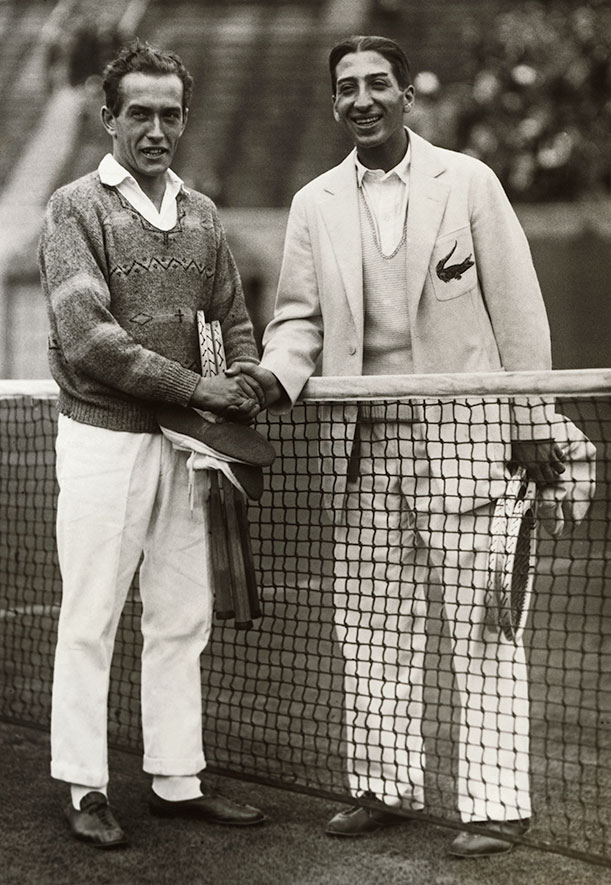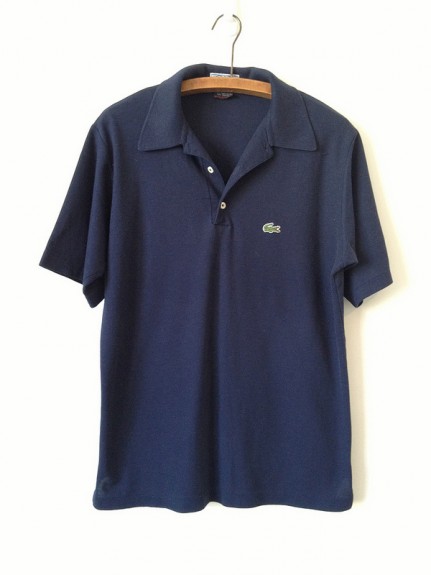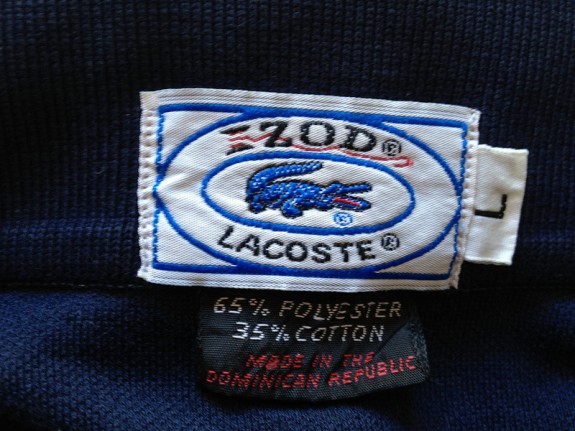The Story Behind the Lacoste Crocodile Shirt
A 1920s French tennis star put the little reptilian logo onto a white polo shirt
![]()

When French tennis players Henri Cochet and René Lacoste met at the net in this undated photo, Lacoste was sporting his signature crocodile on his blazer.
© Underwood & Underwood/Corbis
Frenchman René Lacoste was a superstar tennis player. In 1926 and 1927, he was ranked number one in the world, and during his tennis career, he won seven Grand Slam championship tournaments. But he found the attire associated with the sport restrictive. Tennis whites, as they were called, consisted of a white, long-sleeved button-down shirt, long pants and a tie. It was a lot of clothing to wear when racing to the net to make an overhead shot.
Lacoste was seeking a shirt that was more accommodating to movement. In a 1979 article from People magazine, he elaborated:
“One day I noticed my friend the Marquis of Cholmondeley wearing his polo shirt on the court,” remembers René. ” ‘A practical idea,’ I thought to myself.” It was so practical, in fact, that René commissioned an English tailor to whip up a few shirts in both cotton and wool. “Soon everyone was wearing them,” he smiles.
One school of thought attributes the shirt’s invention to meeting the needs of British polo players in India in the 19th century. The style was emulated in the U.S. by John Brooks, grandson of the founder of Brooks Brothers, after he saw polo players wearing the shirts in England in the late 1800s–hence, the reason we still call it a polo shirt today. It was also referred to as a tennis shirt—piqué knit cotton, short-sleeved, unstarched collar, a placket opening with buttons at the neck, and a “tennis tail” to help keep the shirt tucked in. (That tail even made an impression on artist-poet Joe Brainard, who, in his book-length poem I Remember includes the line: “I remember when those short-sleeved knitted shirts with long tails (to wear ‘out’) with little embroidered alligators on the pockets were popular.”) In 1926, Lacoste first sported the shirt when he played in the U.S. Open in New York City.
Around that same time, Lacoste was dubbed “The Crocodile” by his fans and the media for reasons that are still speculative today: his athletic boldness, his pointy schnoz, and a bet. As GQ explains:
The American press dubbed him the Alligator in ’27, after he wagered for an alligator-skin suitcase with the captain of the French Davis Cup team. When he returned to France, “alligator” became “crocodile,” and Lacoste was known forever after as the Crocodile.
Not only did he embrace the nickname, but he went all out and had a logo of the reptile embroidered onto his blazer. It became his personal brand before there was such a thing.
Once he retired from tennis in the early 1930s, he started the company La Chemise Lacoste with his pal André Gillier, president of the largest French knitwear company at the time, to produce and sell crocodile-emblazoned shirts. The Lacoste tennis shirt made its way to the United States in 1952 and was carefully branded as “the status symbol of the competent sportsman,” an attempt to establish Lacoste in the upper echelons of society.
But, you’re confused, right? Isn’t the crocodile logo associated with Izod? That’s where things get complicated. Lacoste wound up in the United States because it had licensed its brand to Izod (then called Izod of London), which had been seeking out an upscale product.
Izod Lacoste, as the brand became known, initially looked like a flop; there weren’t many customers in the early ’50s for a pricey polo shirt (about $8 then) with a small crocodile sewn onto the chest. But Vincent De Paul Draddy, who originally licensed the Lacoste name for Izod, had a brilliant idea. He provided Izod Lacoste swag to some of his famous buddies, including JFK, President Eisenhower and Bing Crosby, and from there, the shirts caught on, and became easy to find in department stores. People were happy to wear them, especially if the rich and famous were already fans.
In the 1970s and ’80s, sporting an Izod, as the shirts became known, spanned across generations. Teenagers, and particularly those who wanted to assume a preppy look, embraced the style, even popping the collar to assume the full Biff and Muffy look. (See the 1980 book The Official Preppy Handbook by Lisa Birnbach, for more on how the Izod shirt was a key ingredient to achieving that look, or listen to Three 6 Mafia’s Poppin’ My Collar from 2006 for a more contemporary interpretation.)
By the early 1990s, the trend was fading. Lacoste and Izod parted ways in 1993 (Lacoste went further upscale; Izod became more moderately priced and abandoned the crocodile.)
Over the years, the shirt and its iconic logo spawned many imitators and admirers. Designers and brands from diverse price points have taken to embroidering animals onto polo shirts: ponies (Ralph Lauren), marlins (Tommy Bahama), eagles (American Eagle), and even the crocodile itself! The Chinese-based company, Crocodile Garments, was locked in a legal battle with Lacoste over the rights to the crocodile for over a decade until, in 2003, Crocodile Garments conceded to changing its logo. According to CNN, the settlement stated that Crocodile Garments would “have a croc with a tail which rises more or less vertically and it has skin which is much more scaly. It also has bigger eyes.”
Not only was Lacoste, who passed away in 1996, around to see multiple animal-emblazoned polo shirt imitators, but he also was privy to the fashion evolution that took place on the courts–from the whitest of full-coverage tennis whites to the shortest of itty-bitty tennis shorts (thanks, John McEnroe and Jimmy Connors).
/https://tf-cmsv2-smithsonianmag-media.s3.amazonaws.com/accounts/headshot/emily-spivack-240.jpg)




/https://tf-cmsv2-smithsonianmag-media.s3.amazonaws.com/accounts/headshot/emily-spivack-240.jpg)